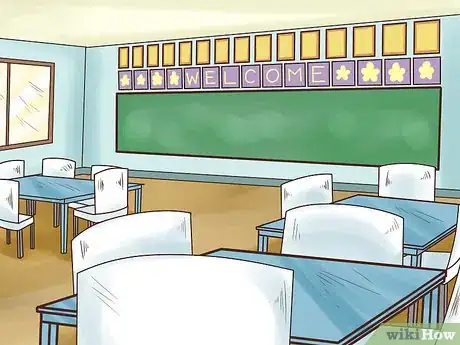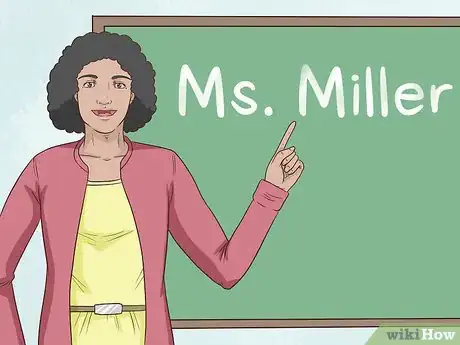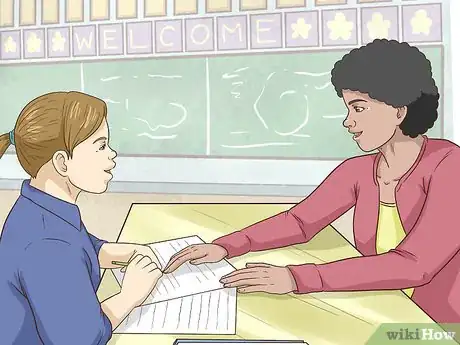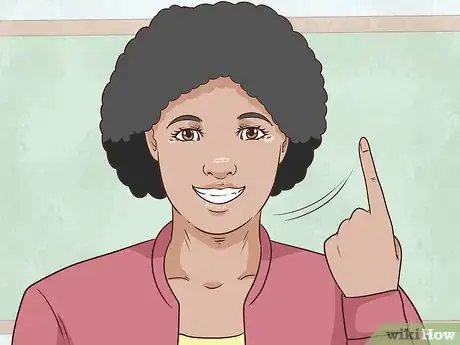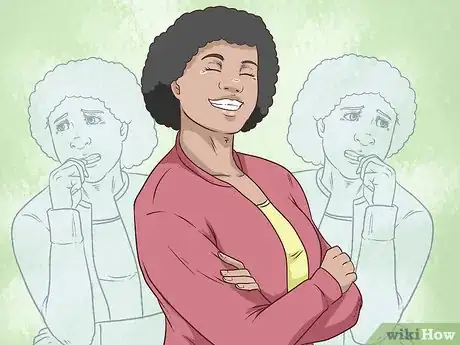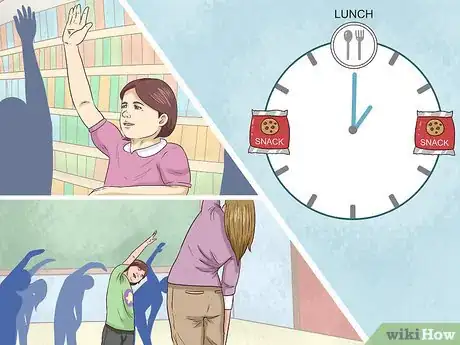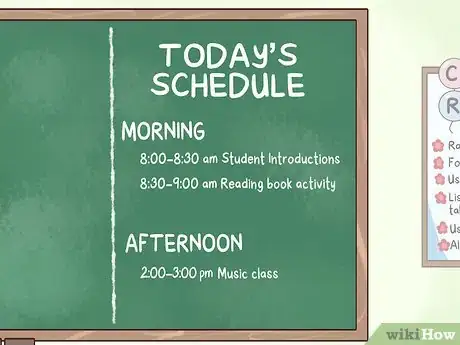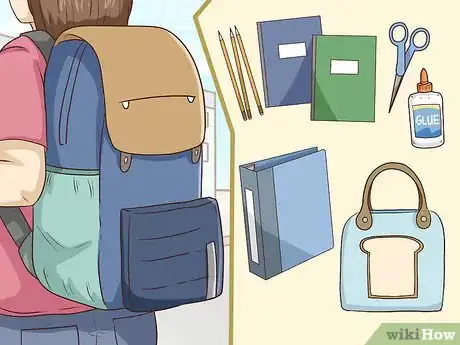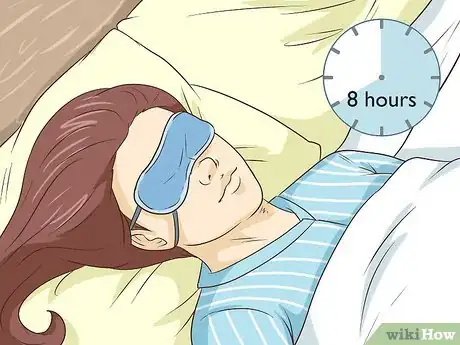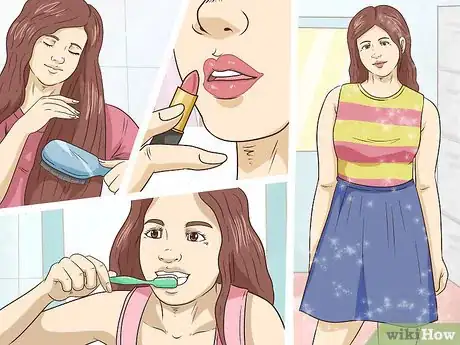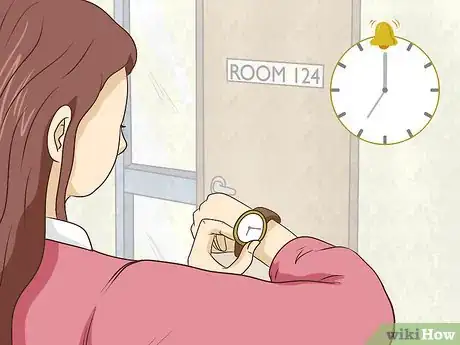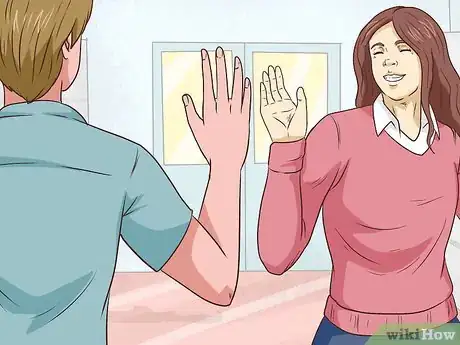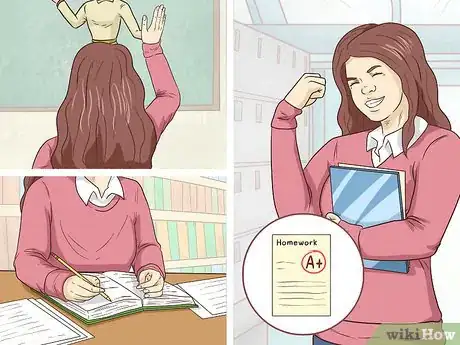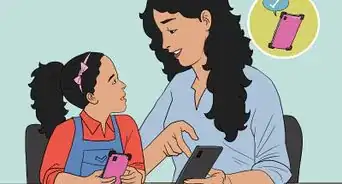This article was co-authored by Ashley Pritchard, MA. Ashley Pritchard is an Academic and School Counselor at Delaware Valley Regional High School in Frenchtown, New Jersey. Ashley has over 3 years of high school, college, and career counseling experience. She has an MA in School Counseling with a specialization in Mental Health from Caldwell University and is certified as an Independent Education Consultant through the University of California, Irvine.
There are 8 references cited in this article, which can be found at the bottom of the page.
wikiHow marks an article as reader-approved once it receives enough positive feedback. This article has 12 testimonials from our readers, earning it our reader-approved status.
This article has been viewed 281,219 times.
Whether you're a teacher about to meet your new class, or you're a student starting a new school year, there are lots of simple ways you can make a great impression. As a teacher, it's important to set the rules and expectations for your class on the first day while also letting your students get to know you and each other. If you're a student, try to be friendly and open to making new friends, and show your teachers you're prepared for the school year.
Steps
Creating a Welcoming Environment
-
1Dress professionally yet comfortably. Students aren’t the only ones who get to pick out a back-to-school outfit—you want your first day outfit to express your personality while making you look professional and confident. Pick out an outfit you’ll be comfortable in, such as a summer dress with a sweater over it or linen slacks and a nice shirt.[1]
- Wear comfortable shoes that breathe, especially if the weather is still warm.
- Follow the school dress code for teachers, if applicable.
-
2Design your classroom to be bright and cheerful. You want your students to walk through the door, see the classroom, and feel excited about learning. Try to add some color to the room by hanging colorful posters on the wall or adding 1 or 2 vibrant rugs. Adding things like bean bag chairs or standing lamps creates a sense of comfort in the room as well.[2]
- You might choose a color scheme, such as turquoise and yellow, for your room and decorate the room with those colors.
- Add things like lights, colorful bins, educational posters, and window decorations.
- While your classroom should have color in it, don't overdo it—too much stimulation on the walls can affect a student's focus.
Advertisement -
3Introduce yourself to the class. You can do this individually with each student as they walk in the door, as well as in a whole-group setting once everyone is seated. Tell the class a little bit about yourself, staying positive and showing your excitement for the year.[3]
- Tell your students what they should call you, and write your name on the board so they learn how to spell it.
- Include exciting things you have planned for the class over the school year in your introduction to get the students excited about what’s to come.
-
4Make a personal connection with the students. While it's important for your students to see you as an authority figure, you also want to create a connection with them as people. Tell your students a little bit about your life and what sort of things you like. By giving them a little information about yourself, your students will be more likely to open up to you.[4]
- Include things like where you’re from, what you did over the summer, and if you have any pets or favorite foods.
- Create a visual that shows your likes and dislikes, which could be an example of a get-to-know-your-class activity that each student makes as well.
-
5Ask the students to share information about themselves. You can do this as a group by asking students to share things with the class such as their name, a fun thing they did over the summer, and what they’re looking forward to this year. Or, you might choose to make it a more private sharing of information, with the students filling out a questionnaire or making a piece of artwork about themselves.[5]
- Consider playing a game that helps the students (and yourself!) learn each other's names.
-
6Smile often to encourage your students to have fun while learning. While some teachers may choose to be strict and serious, smiling creates a warm environment where your students feel comfortable coming to you. Have fun while teaching and give off positive vibes—if you smile, your students will be smiling too![6]
- Portray positive body language by standing up straight, looking your students in the eyes, and smiling genuine smiles whenever possible.
- Smiling also projects a confidence and warmth that shows your students you're approachable.
-
7Be yourself! Your students will be able to tell if you feel nervous or uncomfortable while teaching. Try to let go of any uncertainties and relax so that you’re able to teach your students most effectively. Let your personality shine through and show your students how excited you are to teach them![7]
Setting the Course for the Year
-
1Establish the rules of the classroom for students to follow. This includes things like raising your hand to ask a question, walking quietly in the halls, being respectful of others, and always doing your best. You can either create the list of rules before school starts and hang it up on the wall so it's ready to go, or work with the class on the first day to establish the list of rules together.[8]
- Other rules might include follow directions, listen carefully, or come to class prepared to learn.
- Write the list of rules on a poster board or other large piece of paper so students can read it from their seat throughout the year.
-
2Set a routine so students know what to expect. This includes things like where the students will sit, how you’ll distribute important papers, and how students will go to the bathroom or line up. By clearly explaining how each day will go, your students will feel more prepared and confident.[9]
- Go over the daily routine in detail, such as whether the class will start with a warm up activity, what time they’ll have lunch or recess, and what they should do if they have free time.
- Consider teaching your class hand signals for things like going to the bathroom and getting water so that they don’t need to vocally ask you.
-
3Make a thorough plan for the day that involves creativity. Have an idea of what you’ll do throughout the entire day, such as playing a get-to-know-you game and having the class discuss a summer reading book, making your plan as detailed as possible. It’s okay if you don’t follow the plan exactly, but it’s better to have more things than you have time to do than have lots of unneeded down time.[10]
- For example, write down the times of each activity, such as 8:00-8:30 introductions, 8:30-9:00 summer reading book activity, 9:00-10:00 music class, and so on.
- Write the schedule of your day on the chalkboard or whiteboard so the class can see and refer to it all day if desired.
- Include things in your day such as class introductions, a writing prompt about the summer, or a read-aloud story.
-
4Ask other teachers for help or advice, if needed. Veteran teachers are great sources of information if you have questions or concerns about the first day of school as a teacher. Reach out to other teachers at your school, or even other schools, for helpful answers.
- You might ask another teacher, "What's your favorite get-to-know-you game?" or "How often do you let students go to the bathroom or get water?"
Starting School as a Student
-
1Bring all the supplies you’ll need for the school day. Your school will likely give you a list of supplies you’ll need for the school year, such as binders, folders, or crayons. If you weren’t given a school supply list, bring a notebook and pencils on the first day so you’re prepared.[11]
- Don’t forget to pack your lunch along with your school supplies if you won’t be buying it at school.
-
2Choose an outfit that makes you feel confident. Pick out a back-to-school outfit that you love, and wear comfortable shoes to make your day go easier. Outfit ideas include a dress with sandals, a graphic tee with shorts, or jeans and a nice blouse or button up.[12]
- Make sure you stick to your school’s dress code, if necessary.
- If you have a school uniform, try personalizing your look by adding a watch, necklace, or stylish shoes.
-
3Get a full night's rest before the first day of school. If you show up to school feeling tired, you're not going to have the energy to be your absolute best. Aim for a full 8 hours of sleep if you're a teen, and 9-10 hours if you're in elementary school, to be well-rested and ready for the day. Set your alarm clock so that you wake up on time.[13]
- For example, if you know you need to wake up at 7:00 am, try to be in bed by 8:30 or 9:00 pm.
-
4Have good hygiene to make yourself look presentable. This includes showering before school (or the night before), styling your hair, and brushing your teeth. If you look clean and put-together, you’re more likely to feel confident and excited about the day.[14]
- Consider styling your hair with gel, or braiding it to keep it out of your face.
- Wash your face before school, and apply makeup such as concealer or mascara if desired.
- Paint your nails to give yourself some added flair, if allowed.
-
5Get to school early to arrive at your classes on time. If you’re only in one classroom for the whole day, get to school in the morning a few minutes early so you have time to find out where your class is and what to do with your things. If you go to multiple classrooms throughout the day, try to get to each one on time to make a good impression on your teacher.[15]
- If you don’t know your way around the school well yet, plan to get there early to find out where to go.
- If you're new to the school, see if there's a day before the first day of school when you can go and familiarize yourself with the school.
- Wear a watch to help you keep track of the time throughout the day, if desired.
-
6Smile often and portray positive body language. When you smile, people automatically feel more comfortable and willing to talk to you. Try to sit up straight in class instead of hunched over, and look people in the eyes when they’re talking to you.[16]
- Avoid crossing your arms when talking to people so you appear more inviting.
-
7Be social by talking to old friends and possible new ones. Make an effort to catch up with old friends that you haven’t seen in awhile, asking them how their summer was or which classes they’re in. The first day of school is also a great opportunity to reach out to new people you may not know, introducing yourself and possibly making a new friend.[17]
- If you're new to the school, make an effort to strike up a conversation or smile with as many people as you feel comfortable, as this might lead to the person asking you to sit with them at lunch or hang out during a free period.
- Say hello to people you don’t know in the hallway or in class when the teacher isn’t teaching, especially if you see a new person who may not know anyone yet.
-
8Start good work habits to prepare you for the year. The first day of school sets the tone for the rest of the year, so it’s important to start off strong with your academics. Write down any assignments you have and complete your homework on time to show your teachers you take school seriously and are willing to work hard.[18]
- Listen closely when your teacher speaks, writing down important things like the homework policy and classroom rules.
- Try to raise your hand if you know the answer so your teacher sees you’re willing to participate in class.
- Beginning good work habits in the beginning of the school year will help ensure they stay with you throughout the year.
Expert Q&A
Did you know you can get expert answers for this article?
Unlock expert answers by supporting wikiHow
-
QuestionHow do you set a good impression on the first day of school?
 Ashley Pritchard, MAAshley Pritchard is an Academic and School Counselor at Delaware Valley Regional High School in Frenchtown, New Jersey. Ashley has over 3 years of high school, college, and career counseling experience. She has an MA in School Counseling with a specialization in Mental Health from Caldwell University and is certified as an Independent Education Consultant through the University of California, Irvine.
Ashley Pritchard, MAAshley Pritchard is an Academic and School Counselor at Delaware Valley Regional High School in Frenchtown, New Jersey. Ashley has over 3 years of high school, college, and career counseling experience. She has an MA in School Counseling with a specialization in Mental Health from Caldwell University and is certified as an Independent Education Consultant through the University of California, Irvine.
School Counselor The best thing you can do is pay attention.Whether it's a lecture, presentation, or a friendly conversation with a classmate, make eye contact and show people that you're a listener. If there are any discussions in class or during lunch, engage in the conversation. Illustrating that you're a good listener is the best way to prove that you're a responsible student and a good classmate.
The best thing you can do is pay attention.Whether it's a lecture, presentation, or a friendly conversation with a classmate, make eye contact and show people that you're a listener. If there are any discussions in class or during lunch, engage in the conversation. Illustrating that you're a good listener is the best way to prove that you're a responsible student and a good classmate.
References
- ↑ https://www.edutopia.org/blog/only-1-first-day-school-lisa-mims
- ↑ https://www.edutopia.org/article/dos-and-donts-classroom-decorations
- ↑ https://theeducatorsroom.com/making-good-first-impression-first-day-of-school/
- ↑ https://theeducatorsroom.com/making-good-first-impression-first-day-of-school/
- ↑ https://theeducatorsroom.com/making-good-first-impression-first-day-of-school/
- ↑ https://www.theguardian.com/teacher-network/teacher-blog/2014/sep/04/tips-good-first-impression-new-school-class
- ↑ https://www.theguardian.com/teacher-network/teacher-blog/2014/sep/04/tips-good-first-impression-new-school-class
- ↑ https://www.edutopia.org/blog/only-1-first-day-school-lisa-mims
- ↑ https://www.edutopia.org/blog/only-1-first-day-school-lisa-mims
- ↑ https://theeducatorsroom.com/making-good-first-impression-first-day-of-school/
- ↑ Ashley Pritchard, MA. Academic & School Counselor. Expert Interview. 4 November 2019.
- ↑ https://www.youtube.com/watch?v=oQIVz_N_vl4
- ↑ https://healthfinder.gov/HealthTopics/Category/everyday-healthy-living/mental-health-and-relationship/get-enough-sleep
- ↑ https://www.youtube.com/watch?v=oQIVz_N_vl4
- ↑ https://kidshealth.org/en/kids/back-to-school.html
- ↑ Ashley Pritchard, MA. Academic & School Counselor. Expert Interview. 4 November 2019.
- ↑ Ashley Pritchard, MA. Academic & School Counselor. Expert Interview. 4 November 2019.
- ↑ Ashley Pritchard, MA. Academic & School Counselor. Expert Interview. 4 November 2019.
About This Article
If you want to make a good first impression as a teacher on the first day of school, start by decorating your classroom with colorful posters, beanbags, and rugs to create a warm, cheerful environment. When your students arrive, introduce yourself and share a few things about your personal life, like what you did over the summer and whether you have any pets. Try to project a positive vibe and be sure to mention some of the exciting things you have planned for the year! In addition to connecting with your students, it's also important to establish class rules and introduce a daily routine so your students know what to expect. For tips on making a good impression as a student, read on!

